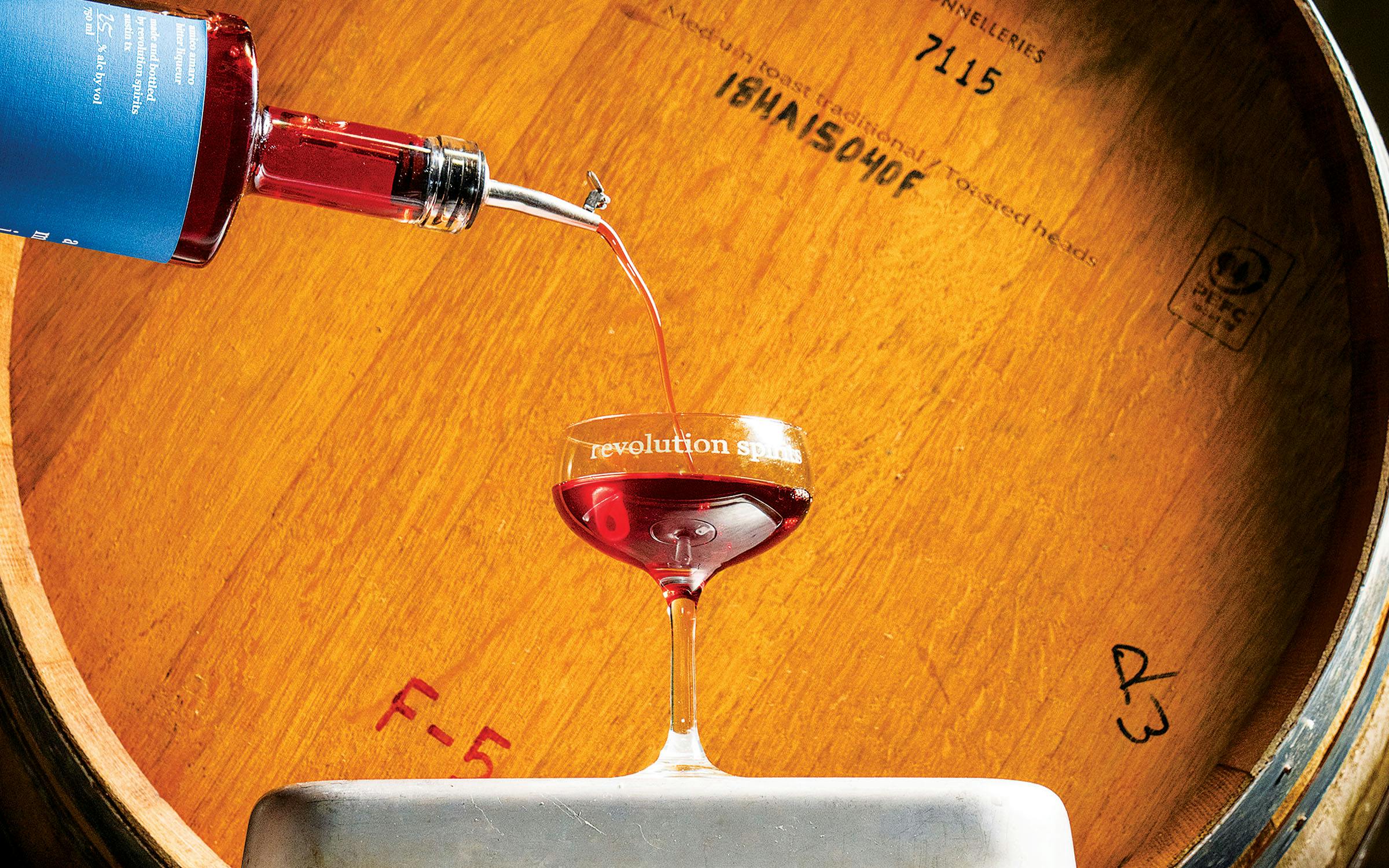The Italian digestifs known as amari date back to the thirteenth century, when monks began making them for medicinal purposes. These bracing after-dinner liqueurs—“amaro,” the singular of “amari,” means “bitter”—are at once ubiquitous and highly localized in Italy, with towns creating proprietary mixes of macerated herbs that are then fermented in neutral liquor. Consumption of amari, whether it’s mixed into drinks or served neat, gained traction in the United States during the craft-cocktail boom of the early aughts, with brands such as Aperol, Campari, and Fernet-Branca
becoming especially popular. Eventually, distillers in the U.S.—and Texas—began to make their own versions.
“Amari give the distiller free rein,” says Brian Meola, the chief executive officer of Revolution Spirits Distilling Co., which debuted the first Texas amaro, Amico Amaro, in 2017. Revolution, located near the Hill Country distillery mecca of Dripping Springs, uses a blend of ingredients that includes charred cedar and damiana (a floral shrub native to South Texas as well as Central and South America and the Caribbean ) to create an elegant liqueur that boasts a complex bitterness and a rich, sweet brightness. Meola, who is of Italian heritage on both sides of his family, chose “Amico” after his mother’s last name.
After the release of Amico Amaro, Revolution turned to the most Texan of ingredients: the pecan. Working with Yegua Creek Farms, a pecan grower and retail market in Elgin, about an hour northeast of Austin, Revolution’s distillers set about creating the first Texas pecan amaro. They based it on the recipe for nocino, an amaro made with unripe walnuts traditionally picked on Saint John the Baptist’s Day (June 24). Using green pecans that are plucked from Yegua’s trees in August and then steeped for a year in a neutral spirit, Revolution created Noce Pecan, an intense, astringent liqueur with notes of menthol and eucalyptus.
Recently, Revolution aged its Amico Amaro in a rye barrel from Milam & Greene Whiskey, a distillery in nearby Blanco. This experiment added notes of whiskey, oak, and spice for a flavor reminiscent of the cocktail known as the Old Pal, made with rye, French vermouth, and Campari. Like Noce Pecan, it’s a limited release.
Meola named it Amico Vecchio, Italian for “old friend.”


Brian Meola at Revolution Spirits, near Dripping Springs.
Photograph by Jeff Wilson


Botanicals are emptied from a holding tank after a gin infusion and maceration is completed.
Photograph by Jeff Wilson


Brian working in the distillery, which debuted the first Texas-made amaro in 2017.
Photograph by Jeff Wilson


The distillery entrance. The tasting room is open on Saturdays.
Photograph by Jeff Wilson


Brian, who is of Italian heritage on both sides of the family, coined Amico Amaro after his mother’s name.
Photograph by Jeff Wilson


Hand-labeling a bottle of La Dama, which is a liqueur made with damiana, a shrub that is native to South Texas.
Photograph by Jeff Wilson


Brian making a cocktail with amaro and house-made hibiscus soda.
Photograph by Jeff Wilson
Getting in the Spirit
Other Texan Amari to Try
Aerodrome Distilling
Amaro
Corpus Christi
One of the coastal city’s premier distilleries rounds out its sophisticated portfolio of small-batch spirits—bourbon, gin, rum, rye, and vodka—with an award-winning digestif. “Aerodrome amaro carefully blends the base notes of bitter gentian, earthy rhubarb, and fragrant angelica while highlighting the bright juiciness of fresh orange, lemon, and grapefruit,” says owner and distiller Nathan Bitz. “Wormwood and wild cherry bark lend balance to the citrusy sweetness.” Enjoy it neat or in a pre-Prohibition cocktail at Aerodrome’s chic naval-themed taproom.
Violet Crown Spirits
Midnight Marigold
Austin
Turmeric and marigold give this collaboration with Sixth Street speakeasy Midnight Cowboy a singular flavor, pairing well with honey and citrus. Purchase it online or at select bars and liquor stores around the state.
William Price Distilling, Honey Badger Amaro
Clear Lake
This Houston-area distillery turned to Dillon Carpenter, a longtime mixologist at Clear Lake’s popular Rosewater Bar, for a ten-botanical amaro. The liqueur, which offers notes of burnt caramel and orange zest at the fore, is available at William Price’s taproom, online, and at select retailers.
This article originally appeared in the August 2024 issue of Texas Monthly with the headline “The Bitter Trend.” Subscribe today.

